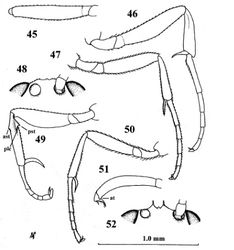Neoneurus clypeatus
| Notice: | This page is derived from the original publication listed below, whose author(s) should always be credited. Further contributors may edit and improve the content of this page and, consequently, need to be credited as well (see page history). Any assessment of factual correctness requires a careful review of the original article as well as of subsequent contributions.
If you are uncertain whether your planned contribution is correct or not, we suggest that you use the associated discussion page instead of editing the page directly. This page should be cited as follows (rationale):
Citation formats to copy and paste
BibTeX: @article{Gómez2011ZooKeys125, RIS/ Endnote: TY - JOUR Wikipedia/ Citizendium: <ref name="Gómez2011ZooKeys125">{{Citation See also the citation download page at the journal. |
Ordo: Hymenoptera
Familia: Braconidae
Genus: Neoneurus
Name
Neoneurus clypeatus (Foerster, 1862) – Wikispecies link – Pensoft Profile
Material
Netherlands (Meijendel, dunes near The Hague; Rockanje, wet Salix repens dunes; Oostkapelle, Oranjezon; ‘t Harde). Mostly collected in August and September, but a few specimens were collected in May and June.
Synonyms
Elasmosoma viennense Giraud, 1871, syn. n. (examined). According to Shaw (1992)[1] the holotype of Neoneurus clypeatus is a male and has the third and fourth antennal segments shorter and less densely setose and the hind tibial spurs and hind tarsal segments shorter than in the male holotype of Elasmosoma viennense; the body, hind coxa and the antenna of the holotype of Neoneurus clypeatus are much paler than those of Elasmosoma viennense. Elasmosoma viennense has the tegulae pale yellowish; dark brown or brown, the clypeus yellowish-white, yellowish-brown or brown and dorsally darkened, the hind coxa yellowish; largely black or dark brown. However, the holotype of Neoneurus clypeatus is coloured as a typical female and it may be either just an anomaly or a female. In general, Foerster types are paler by ageing than types from other collections of similar age, including Giraud types and limited weight should be given to colour differences in general.
Notes
If the scapus and tegulae of a male are pale yellowish or whitish, the hind coxa largely yellowish-brown and the vertex finely granulate, the specimen may represent the unknown male of Neoneurus vesculus or Neoneurus recticalcar, the latter probably has a slenderer fore femur and tibia than the former.
Taxon Treatment
- Gómez Durán, J; van Achterberg, C; 2011: Oviposition behaviour of four ant parasitoids (Hymenoptera, Braconidae, Euphorinae, Neoneurini and Ichneumonidae, Hybrizontinae), with the description of three new European species ZooKeys, 125: 59-106. doi
Other References
- ↑ Shaw S (1992) Seven new North American species of Neoneurus (Hymenoptera: Braconidae). Proceedings of the Entomological Society of Washington 94 (1): 26-47.
Images
|

